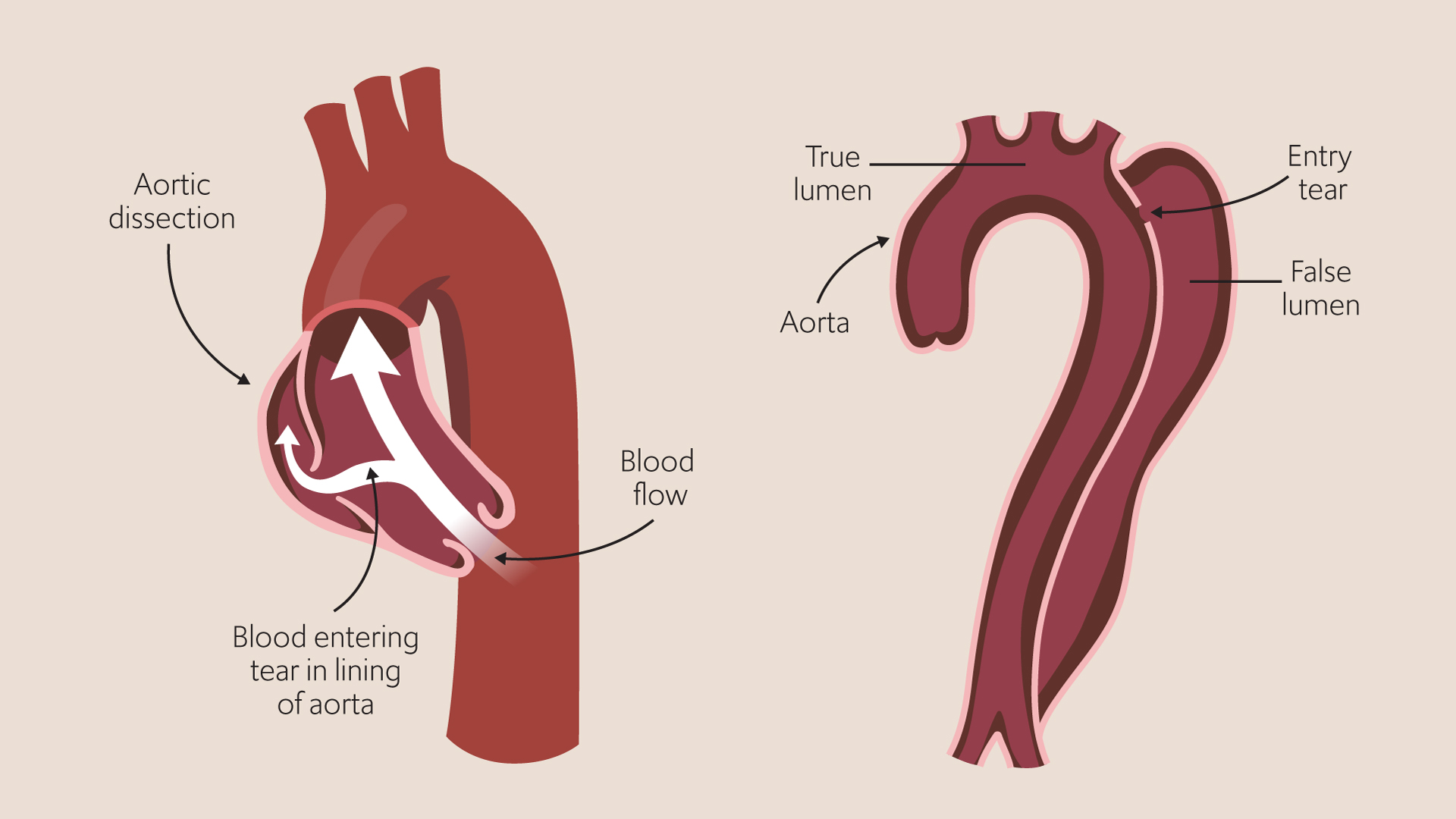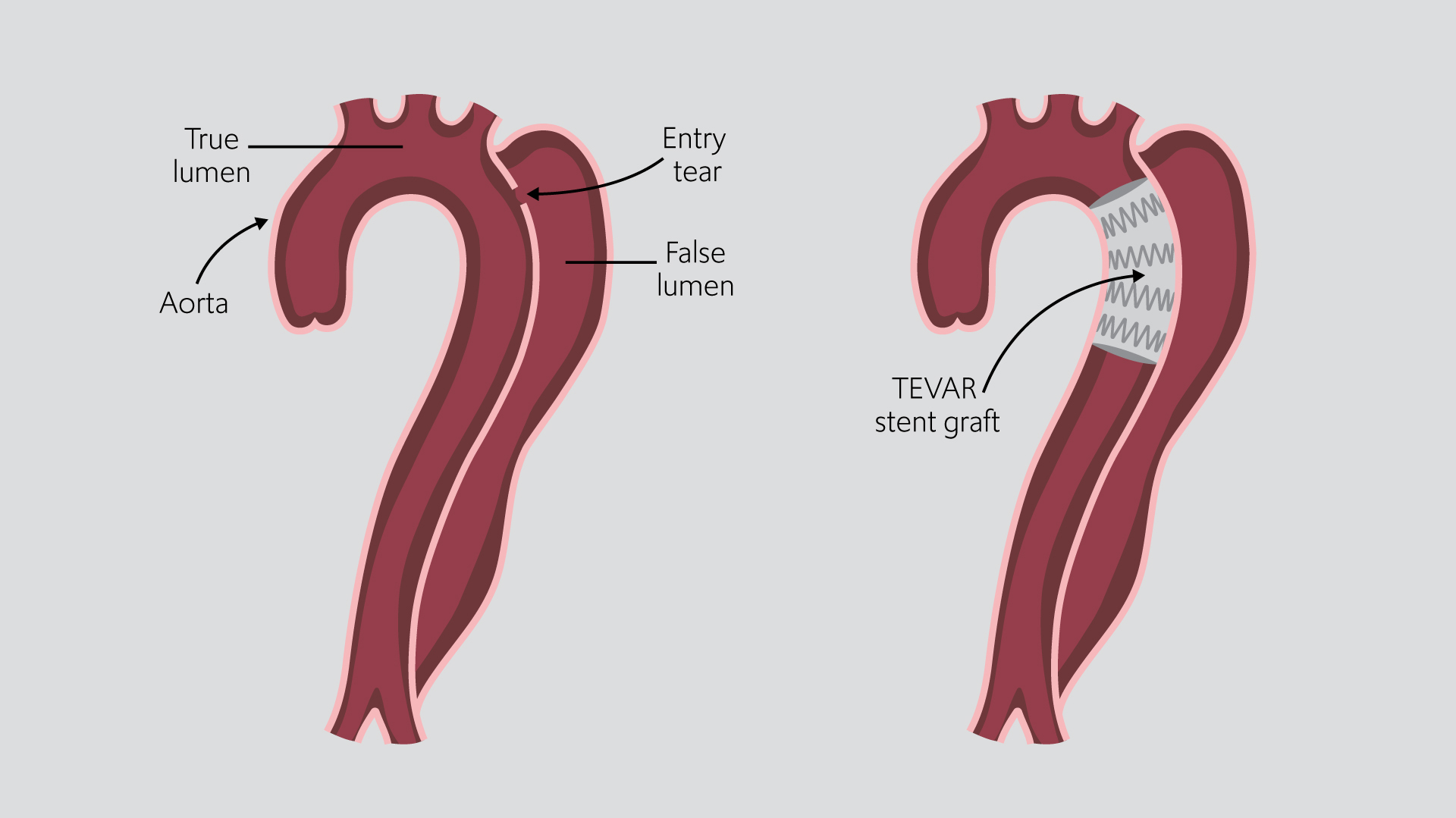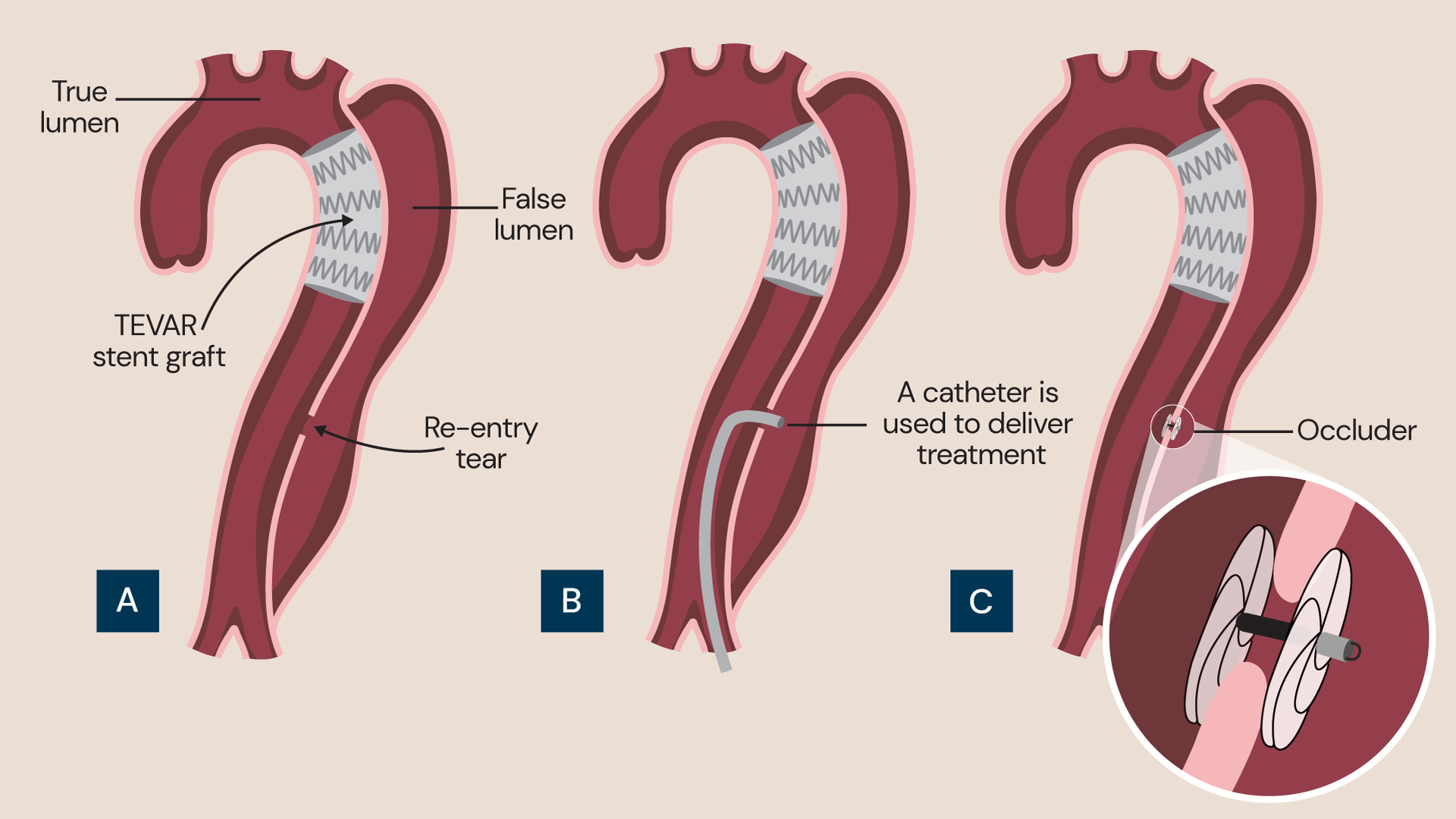If you have an aortic dissection, you will require standard open surgical or endovascular (minimally invasive) procedures, but your doctor may also recommend FLIRT. This is a minimally invasive procedure to treat new tears in the aorta which have occurred following previous standard operations or procedures.
FLIRT, also known as False Lumen Intervention to Promote Remodelling and Thrombosis, supports the aorta by sealing a residual tear and allowing blood to flow in the true lumen, minimising the risk of rupture.
What is aortic dissection?
Aortic dissection is a serious condition whereby the aorta’s inner layer experiences a tear. Aortic dissection is often urgent, as blood rushes between the inner and middle layers of the aortic wall and accumulates in what is called a ‘false lumen’.
A false lumen is a new channel which forms between the inner and middle layers of the aortic wall, causing them to separate (or dissect). If not treated promptly, this can lead to rupture of the aorta which is often fatal.

Type A (left) and type B (right) aortic dissection. The entry tear of an aortic dissection can result in blood flowing between the layers of the aortic wall, resulting in the development of a false lumen.
There are two types of aortic dissection – type A and type B. Type A dissection occurs in the section of the aorta which lies closest to the heart. It is usually life-threatening and requires urgent open-heart surgery to replace or repair the dissected aorta.
Type B aortic dissection occurs further down the aorta, further away from the heart. Depending on exactly where the dissection occurs and its impact on the blood flow, surgery for type B dissection isn’t always required urgently. This gives the patient and cardiologist or aortic specialist more time to plan for a procedure called TEVAR as a form of treatment.
Aortic dissection symptoms can vary depending on which type of dissection you have. Symptoms can include:
- tearing or stabbing sensation in the chest or back
- shortness of breath
- fainting
- weak pulse
- temporary loss of vision
- compromised blood flow to legs
- stroke symptoms
What is the TEVAR procedure?
As the FLIRT procedure is offered to patients following previous intervention using the TEVAR procedure, understanding what happens in TEVAR treatment is helpful.
TEVAR (Thoracic EndoVascular Aortic Repair) is a minimally invasive non-surgical procedure used to treat thoracic aortic aneurysms and aortic dissection. Our consultant cardiologist at Royal Brompton Hospital, Professor Christoph Nienaber, pioneered both the TEVAR and FLIRT procedures.
TEVAR involves inserting a stent graft through a small incision in the groin, and guidance of a wire in the true lumen to the section of the aorta which requires treatment. The stent graft essentially scaffolds the aorta, providing additional support to its weakened or damaged walls, therefore allowing blood to flow through the graft and the true lumen again.

(A) A tear in the wall of the aorta can result in blood flowing in between its layers, resulting in the development of a ‘false lumen’. (B) The TEVAR procedure is the recommended minimally invasive treatment and positions a stent graft to cover the tear, enabling blood flow to return to the true lumen.
TEVAR is now the preferred alternative to open heart surgery for aortic repair of the descending aorta. This is because TEVAR is less invasive, reducing the risk of complications, allowing patients to have a shorter recovery time, and improving overall patient outcomes.
What is the FLIRT procedure?
Although the TEVAR procedure is very successful in treating aortic dissection for the vast majority of cases, some patients may experience a new tear in their aorta. Similarly, the stent graft inserted during TEVAR may move slightly over time, which can expose the original tear and allow blood to flow back into the false lumen, increasing the risk of complications and rupture once more.
Repeat false lumen expansion or flow is usually detected between three months and three years after a TEVAR procedure during follow-up appointments.
As a solution for the repeat expansion of the false lumen, our cardiology experts developed FLIRT. This is an innovative procedure to seal any new tear and strengthen the aorta again, diverting the blood down the true lumen.
FLIRT relies on using advanced imaging techniques to guide a catheter and wire through access in your arm or groin straight to your aorta. An occluder (a plug-like device) seals the gap between the true lumen and the false lumen, preventing leakage of blood to the false lumen.

(A) A residual tear in the aorta – called a ‘re-entry tear’ – can result in blood flowing back into the false lumen after a TEVAR procedure. (B) The FLIRT procedure: A catheter is used to precisely target the tear leading into the false lumen, where an occluder (a plug-like device) is used to seal the communication between the true and false lumen. (C) The occluder shown in place.
Using an occluder to plug the gap is an efficient, minimalistic strategy which also helps to avoid the need for an additional stent graft later in life.
Who is FLIRT suitable for?
The FLIRT procedure is designed for patients who have had a surgical graft or TEVAR treatment in the past, due to a previous aortic dissection or aneurysm, and are now experiencing a false lumen expansion again.
The FLIRT procedure is especially suitable for older patients due to its quicker, easier recovery than other more invasive interventions or surgeries. Additionally, as TEVAR treatment is usually not recommended to younger patients, most patients who will require the FLIRT procedure will also tend to be in the older age bracket.
What happens in the FLIRT procedure?
Before undergoing the FLIRT procedure, you will meet with your consultant surgeon, cardiologist or interventional specialist for a thorough evaluation. This can involve blood tests, imaging tests like CT scans or a cardiac MRI, and a physical examination.
You’ll receive instructions on preparing for the procedure, information on whether or not you need to fast prior to having the anaesthetic, and guidance on whether you need to stop taking any medications.
The FLIRT procedure is carried out under general anaesthetic and takes around 90 minutes to perform. It begins with a small puncture in your groin or arm and threading a catheter through to reach the aorta.
Through this catheter, the occluder is passed up to the point of the aorta which requires repair. The occluder expands in this section to seal off the tear and essentially acts as a plug, preventing blood from flowing into the false lumen.
The surgeon will use imaging such as fluoroscopy or ultrasound to ensure the occluder is in the correct position. They will then remove the catheter and close the incision in your groin or arm artery.
Following the procedure, you’ll be taken into a recovery room to be monitored. You’ll need to lie still and keep your legs straight to allow the puncture site to heal. If required, we can administer pain medication to help you manage any discomfort.
Most of our patients stay in the hospital for 2 days following the FLIRT procedure. You may require around 2 weeks to recover at home before you can return to your daily activities.
FLIRT risks and benefits
The main benefit of the FLIRT procedure is that it avoids the risk of repeat TEVAR or open surgery, with some other advantages including:
Smaller incisions: FLIRT is carried out through one small puncture in the groin or arm, instead of a larger incision with open surgery or repeat TEVAR.
Less time in hospital: Patients return home much sooner after the FLIRT procedure than they do after traditional TEVAR or open surgery for aortic repair.
Quicker recovery period: Due to its minimally invasive nature, patients mobilise very quickly after FLIRT and most return to their regular daily activities soon.
Reduced complications: With a small incision, short procedure and swift recovery, the risk of complications after the FLIRT procedure is significantly reduced when compared to open surgery or repeat TEVAR with a lower chance of developing infections and complications.
As with the TEVAR procedure, complications from the FLIRT procedure are rare, but it’s important to be aware of the following potential risks:
- bleeding at the puncture site
- damage to blood vessels or organs
- infection
- leaking around the treatment site due to incomplete seal
Your surgeon or aortic specialist will discuss the risks and benefits of having the FLIRT procedure with you before you undergo treatment, in order for you to make a balanced and informed decision.
Is FLIRT right for me?
We have a dedicated aortopathy clinic at our hospitals where we see our patients three months after their surgery or TEVAR procedure, and then at annual intervals. We perform CT imaging each time to monitor the aorta and check for any blood flow into the false lumen, which may lead to expansion. If expansion is found, our team of expert cardiologists will schedule an appointment to carry out the FLIRT procedure, rectifying the problem.
Our cardiologists estimate that around two thirds of patients with false lumen expansion following TEVAR treatment experience no symptoms or very mild symptoms such as mild back or chest pain.
We monitor almost 400 patients each year and so far have identified 20 patients in need of the FLIRT procedure. Of these patients, all FLIRT procedures were completed successfully with no complications.
Locations
The FLIRT procedure is offered at the following locations:
Discover our cardiology specialists
Meet our team of renowned cardiology specialists. From cardiovascular health assessments to innovative interventions, our experts are committed to delivering personalised care designed just for you.
